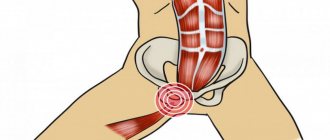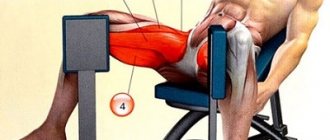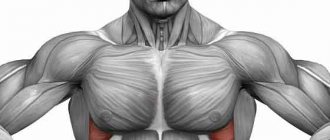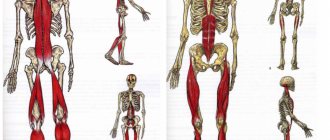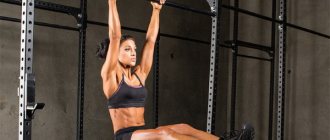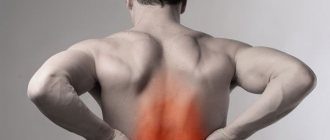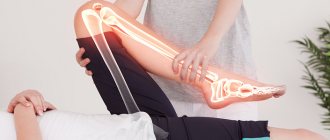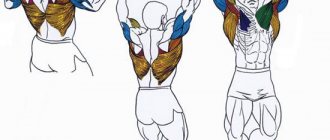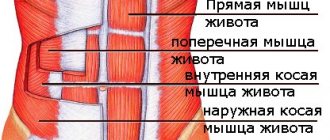The quadriceps is the largest muscle group in the entire human body. It includes four heads: straight, medial, lateral and middle. Usually they all work together, and when you need to pump up your legs, tighten your hip line, they do exercises for the entire quadriceps.
Many novice athletes, especially men, when they come to the gym, focus on the upper body and abs on the abdomen, forgetting that for a harmonious figure you also need to pump up your quadriceps femoris. Girls do exercises for the abs and buttocks, although in the second case the leg muscles are also involved, you need to remember about separate isolating movements for this part of the body.
So, we figured out what the quadriceps is, now we’ll look at where it is located and how to pump it up at home. This muscle group is located on the front of the leg, straight and slightly to the side of the kneecap. Its main function is to extend the leg at the knee, as well as bend the leg, lift the hips towards the chest, and maintain balance when tilting the pelvis forward.
It is impossible to say unequivocally which muscle of all four heads is more important and which one needs to do more repetitions. You need to download everything at once. It is the appearance of this muscle that determines how the leg will look from the side and from the front.
Features of working with quadriceps
The main thing that beginners need to remember even during their first visits to the gym is that quadriceps exercises should not be “postponed for later.” Why? Because uneven development of the upper and lower body is not only unattractive. It makes it extremely difficult to “even out” such imbalances in the future. In other words, powerful biceps with legs that resemble toothpicks are evidence of:
- or professional unsuitability of the trainer;
- or the excessive independence of a person who has taken responsibility for building his own body at home with an absolutely amateurish level of knowledge about the essence of the issue.
For this reason, strength gymnastics for quadriceps must be built according to a clearly developed plan, and include the development of each of the 4 muscles separately.
What exercises are recommended for beginners to do first? These should be called:
- Hyperextension, which allows you to simultaneously train the lower back. This is necessary to protect against injury when moving on to heavier exercises.
- Leg presses. They have a beneficial effect not only on the quadriceps, but also on the ligaments.
- Leg extensions in specialized simulators.
What else is important to remember when working with quadriceps? Since the strength and reaction speed of the muscles included in its composition are not the same, it is necessary to add aerobic exercises to strength exercises. First of all, this is running, swimming, cycling and, if possible and according to the season, skiing
It is enough to conduct training sessions once a week. At the same time, choosing from 2 to 3 exercises (with three to four approaches of 10 repetitions each).
Main functions of the quadriceps:
- Maintaining the body in a stable upright position;
- Movement of the lower leg in the knee joint;
- Participates in tilting the pelvis and pulling the lower extremities towards the abdomen.
As you have already seen, the quadriceps is a large muscle. This means that it will take her longer to recover. It is advisable to organize quadriceps training once a week. Recovery is a prerequisite for muscle growth. Muscle tissue increases in volume during the period of supercompensation. For large muscle areas this period is longer. Therefore, if you plan to have a “leg day” a couple of times a week, just distribute the load evenly. Focus on the quadriceps in one workout, and the hamstrings in another.
For beginners, it is better to start training with basic and multi-joint exercises. When you have developed good technique, built up endurance and muscle strength, you can begin to work out in detail the muscle relief of the quadriceps.
Basic quadriceps exercise
The development of this muscle group is based on the use of basic exercises that contribute to the development of strength and endurance of the athlete, associated with an increase in the volume of muscle fibers.
Squats
- The bar of the bar should not be located in the neck, but on the back of the deltoids and trapezius.
- Keep your back straight and your shoulder blades pulled together so that the weight of the barbell is evenly distributed. The chin is directed upward so as not to provoke forward bends, which overload the lower back and can lead to injury.
- To maintain balance, your feet are positioned wider than your shoulders and your toes point to the sides.
- The exercise begins with moving the pelvis back, as if you need to squat.
- The knees of the legs should be fixed when the back of the thigh is parallel to the floor, but it can be lower. It all depends on the athlete’s level of preparation and the task at hand. The lower the squat, the more effectively the muscles are trained.
- You should rise from a squat without sudden movements, maintaining balance. When the highest point is reached, the legs do not straighten completely, but remain somewhat bent, in order to avoid injuries to the knee joint.
When doing these exercises, you should not get carried away with maximum loads. For proper quadriceps development, it may be better to replace the barbell squat with regular front squats, but also with a barbell.
Front Squats
This exercise is similar to the previous one, but the bar has a slightly different arrangement, which strengthens the quadriceps more. The technique for performing this exercise is as follows:
- The grip is performed with straight arms located slightly wider than the shoulder.
- The bar is located on the front of the shoulders.
- The arms are bent, and their upper parts are parallel to the floor.
- After fixing the bar in this position, a squat is performed, the technique of which is similar to the previous one.
Hack squats
Hack - a simulator designed to strengthen the quadriceps, while exercises on it reduce the load on the spine. The lower back is located on a movable base, the arms are held on the handrails, and the legs are on an inclined plane. By changing the width of the feet, you can shift the load relative to the lateral part of the hips.
- When performing the exercise, do not rush and do not make sudden movements.
- When reaching maximum load, it is not recommended to fully extend your knees.
- The entire load should fall on the quadriceps.
- You should not spread your knees beyond the line of your toes.
Leg press on the machine
The main exercise that actively works the legs, but at the same time removes all the effort from the back. If the feet are placed as close to each other as possible, then the quadriceps also take part in the work.
- To avoid stress in the back area, the lower back should be pressed tightly against the seat.
- In this case, you should make sure that your knees do not fully extend and also touch your chest at the final stage of the exercise.
- If the feet are spread slightly wider, the inner rays of the thigh muscles will work more.
Lunges
- The feet should be parallel, but slightly wider than the hips.
- In this case, wide steps are taken, and the leg bent at the knee joint should form a right angle in relation to the floor.
- The position of the knee must be controlled: it must be motionless and not “walk” from side to side.
- The knee of the back leg is located as close to the floor as possible, but does not touch it.
- When coming out of a lunge, the quadriceps works as much as possible.
When using a barbell, you should strictly follow the barbell technique described above in the text under the subheadings “barbell squats.” If dumbbells are used, then the arms are parallel to the body and are motionless.
Quadriceps structure
- The femoral part of the muscle is its lateral surface and takes part in all forms of movement in which the legs are involved. It is the most circular component of this muscle bundle. It is also called the lateral muscle.
- The inner part of the thigh is formed by the vastus medialis muscle. In shape it resembles a certain roundness on the inside of the knee. The medial muscle is also designed to allow normal flexion and extension of the knee.
- Between the medial and lateral muscles is the vastus intermedius muscle, which partially extends beyond the edges of these two muscles at their junction with the knee. Mainly used when jumping and running, as well as during squats.
- On the front of the thigh is the rectus muscle, which is part of the quadriceps complex. It is longer and forms the anterior semicircular part of the thigh. It is interesting in that it is not attached to the femur, but is actively involved in the flexion and extension of the legs.
The quadriceps consists of different muscle groups, which are characterized by the speed at which different exercises are performed: slow and fast muscle fibers. As a result, exercises should have both strength and aerobic loads.
Exercises for quadriceps femoris
If the main object of training is the quadriceps femoris muscle, exercises to pump it up should make up at least 70% of the total training complex
Before training, it is important to warm up your muscles well and prepare them for heavy loads.
Squats
Weighted squats are considered a basic exercise to build up your leg muscles. You should not immediately take on very high weights. In this case, the gluteal muscles will undergo hypertrophy. For the harmonious development of leg muscles, it is recommended to alternate squats with dumbbells and a barbell. This will allow you to evenly distribute the load and train the muscles you need.
Squats
Barbell squats are a fairly energy-intensive exercise, so it’s best to do them at the beginning of your workout. The main thing is to choose the optimal weight. Usually do 3-5 sets of 10-15 repetitions. To prevent spinal injuries, it is recommended to strictly follow the execution technique, as well as use a belt to fix the lumbar region.
Squats with dumbbells can be performed both in the gym and at home. Dumbbells are held along the sides of the body or in hands raised to shoulder level. Your back should be straight and your heels should be close to the floor.
Squats on a hack machine
Squats in a hack machine can reduce the load on your lower back. The movable platform for the back is located at an angle of 15 degrees relative to the floor. There are handles and pillows on top for shoulder support. By changing the position of the feet and the distance between them, you can distribute the load across certain muscle groups.
Leg press on the machine
The exercise is performed while lying on the simulator. To load the quadriceps femoris muscle in isolation when performing this exercise, the feet are placed at a distance of about 10 cm closer to the lower edge of the movable platform of the simulator. Try to keep your quadriceps tense with your legs bent and not fully extend them when lifting the platform.
Leg press
Leg extension
The exercise is aimed at training the rectus quadriceps muscle. While sitting on the machine, firmly grasp the handles from below. The feet are placed under the bolster parallel to each other. As you exhale, slowly straighten your legs, lifting the roller. Hold your legs in this position for several seconds and just as slowly return to the starting position.
Seated leg extension
To increase the load on the quadriceps, the exercise can be performed with each leg in turn. It is enough to do 10-15 repetitions on one leg.
Anatomy of the quadriceps femoris muscle
The quadriceps is a kind of conglomerate of four muscle masses:
- direct;
- lateral;
- medial;
- intermediate.
In the patella of the femur, all these heads form a common tendon, its attachment goes to the superficial structures of the tibia and the kneecap.
The anatomy of the powerful quadriceps femoris muscle is based on the structure of its components.
The rectus femoris muscle arises from the acetabulum. Between the bone surface and muscle tissue is the joint capsule. Next, the muscle turns down the front side of the hip joint, protruding closer to the skin between the sartorius muscle element and the tensor fasciae lata. The end of the muscle flows into the tendon of the quadriceps femoris muscle, which is attached to the top of the kneecap. Basically, hip flexion is carried out with its help.
The largest muscle fiber of the quadriceps muscle is the vastus lateralis. Its top is attached by tendon bundles to the head of the femur and to the lateral intermuscular septum. Below it joins the tendon common to the quadriceps mass.
The vastus intermedius muscle starts on the ventral part of the thigh bone. It attaches to the top of the knee cup and participates in the creation of a single tendon bundle.
The attachment of the upper part of another muscle mass, the broad medial one, occurs in the area between the two trochanters, near the medial lip of the linea aspera. Then it passes along the medial side of the thigh. At the bottom it also joins into a tendon with the rest of the quadriceps.
The blood supply to the quadriceps muscle is provided by the femoral artery, which is a continuation of the iliac artery. The innervation of muscle tissue is carried out by the femoral nerve, which regulates motor abilities.
To understand exactly where these hip muscles are located, you can look at the tense legs of athletes. In people who are keen on bodybuilding and powerlifting, the muscle mass is very pronounced.
We compose a set of movements
Monotony becomes boring not only for you, but also for your muscles. Experts recommend changing the complex every two months, choosing other effective exercises so that the load alternates at least a little. This will help you work your muscles more effectively.
So, we offer you the best options that you can use in various modifications, choosing how to reduce or how to increase your quadriceps.
Plan to spend about an hour training, and be sure to warm up and stretch your joints, especially if you work out with weights. Any load on the knees harms the joints, so control your zeal, especially at first. Increase the weight gradually.
Lunges
It is most effective to do them with dumbbells. Hands down. Lunge forward and backward so that your thigh is parallel to the floor, and alternate legs. It is advisable to do 15-20 repetitions. Lunges to the side are also good; in this case, we hold the dumbbell in the same hand where we lunge. If space allows, you can make the movement not in place, but as if stepping forward or backward.
Squats
The best exercise for the quadriceps femoris. And they are good because you can do them in different variations, depending on which part of the leg you need to work more strongly. If your feet are shoulder-width apart, the quadriceps swings evenly; wider than the shoulders, the inner part of the muscle works; narrower than the shoulders, the lateral head of the quadriceps tenses. Plan your workout yourself the way you like by choosing squats:
- The simplest ones. Feet shoulder-width apart, narrower or wider, squat to an angle of 90 degrees.
- Asymmetrical. One leg stands shoulder-width apart slightly in front of the other.
- Lateral. Feet wider than shoulder width, squat to the side, transferring weight to one leg.
- With springs. Regular squats, but at the bottom point we spring our pelvis 3 times, then we stand up.
- With jumping out. Rising, we jump up, straightening our legs, then squat from the jump.
A regular squat can be made more effective if you place your heels on a small stand, 2-3 centimeters. This way, the gluteal muscles are less tense, and more load goes directly to the quadriceps. If you work out with dumbbells, try holding them near your chest, this will also increase the load.
Rise
To do this, you will need a step platform, a stand, or some kind of elevation. A sturdy box, low stool, or something similar. The left leg is bent at the knee and stands on an elevation. Right straight and on the floor. When performing the movement, we forcefully straighten our left leg and lift our right leg towards it. It turns out that you are standing on a support with one foot, the other is next to it, but is not supported, hanging in the air. Lower your right leg to the floor again and repeat. There are two variations aimed at the outer part and the entire quadriceps muscle:
- Sideways to the stand;
- Facing the stand.
Do the quadriceps exercise vigorously but gently to maintain balance. It may be more comfortable to lean against a wall, but don't use your hands to help yourself. The lifting should be due to the force of the leg.
By the way, walking up the stairs can be an analogue of climbing. Take a backpack, put at least 10 kilograms of something in it (dumbbells, bottled water) and walk up and down the stairs in the entrance several times (the number of passes depends on the height of the house, depend on your strength).
How to pump up the lateral thigh muscle
Place your feet approximately shoulder-width apart. As you inhale, moving your pelvis back, bend your knees to a right angle.
Training the vast lateralis quadriceps muscle - “breeches”
As you exhale, rise to the starting position. When performing the exercise, you need to fulfill several important conditions: Engage your abdominal muscles, this will ease the load on your back 2. Try to keep your back as straight as possible 3.
Try to keep your heels on the floor all the time 4. Don’t hold your breath It is noted that a slightly wider stance of the legs allows you to better work the lateral thigh muscle.
It is great for working on the outer thighs. Set a comfortable weight, stand under the supports and place your feet shoulder-width apart. Slowly lower yourself as far as possible and return to the starting position.
It is important!
Avoid sudden movements and do not straighten your knees completely. Pain on the outer part of how to write with a tampon is usually associated with soft tissues: The vastus lateralis muscle hurts mainly due to injuries or unusually strong loads, for example, climbing a mountain, a long ski trip, etc.
How to pump up your hamstrings? Anatoly Smirnov
Treatment in this case is standard: There are other causes of pain in the area of the outer thigh.
Actually, this was all the structural and anatomical information on the leg muscles, now we move directly to the pumping-theoretical side of the issue.
This subchapter will provide information regarding the features of leg pumping. So let's look at each one.
The influence of genetics or legs are laid from youth. There is a theory that a certain type of physical activity in a child's early puberty affects the genetic type of muscle tissue fibers.
Exercises for the vastus lateralis muscle
Thus, if you are young from 7 years old and want to connect your life with bodybuilding in the future or simply be massive, especially in the legs, then you need to pay attention to sports such as: These are active in
As practice shows, people who preferred them in their youth, after puberty, had legs with good growth potential.
In these young athletes, white fast muscle fibers became the dominant muscle fibers in the legs. Subsequently engaged in bodybuilding, they have large volumes.
Helpful advice!
When it comes to proper leg training, understanding the fiber types is paramount.
In this regard, it will be useful to have the following information:. The main task in women's leg training is to correct problem areas and local increase in volume, such as how to pump up the lateral thigh muscle of the buttocks, without swinging the front thigh.
The main correction zones are:. In addition, any young lady wants rounded and voluminous buttocks without enlarging her hips. All these issues can be resolved by fine-tuning leg training.
Despite the fact that the muscle groups are the same for everyone, male and female legs have the following structural and visual differences.
Uff-ff, well, it seems like you’ve given it all away..., now you have a theory for creating legged legs: So far they’ve answered only in theory, yes there’s a lot of it, yes it’s tedious, but not everything is Maslenitsa for the cat, sometimes you have to force it.
The next article will be exclusively practical and there we will learn many practical tricks for pumping up the legs and, of course, we will analyze specific programs.
I consider our note complete, see you soon! I will be glad to see you working together! With respect and gratitude, Dmitry Protasov.
muscles, not torrents!
Shrugs from the lower block. We study all the subtleties and secrets. Retracting the arm to the side on the block. We study all the subtleties and... What makes muscles grow? Dumbbell bench press at an upward angle.
Quadriceps exercises
In fact, girls’ legs are the strongest part of the body, so with proper nutrition and intensive training, the result will not be long in coming if you know how to pump up your quadriceps. The first and simplest exercise that immediately comes to mind is squats: in this case, no equipment is needed, you work with your own weight.
But there are other equally effective exercises. Let's list some of the best exercises to strengthen the quadriceps of the legs in girls for the gym and for training at home.
The best exercises in the gym are:
- Squats using dumbbells or a barbell. The barbell should be located on the trapezius muscles, but in no case on the neck. Keep your back straight and squeeze your shoulder blades together as much as possible; this will allow the weight of the barbell to be evenly distributed. In addition, there are some general rules to keep in mind for any squat:
- feet slightly wider than shoulder width to maintain balance;
- the chin should always look up;
- the squat should begin by moving the pelvis back, you can imagine the movement when we want to sit down on a chair;
- squats are done until the back of the thigh is parallel to the floor;
- knees should be motionless and not extend beyond the toes to avoid injury to the knee joints;
- return to the starting position smoothly, without sudden movements.
Squats in a hack machine: the lumbar region is pressed tightly against the movable platform, your hands need to hold on to the handrails, your legs are on an inclined platform. Squats should be smooth.
Smith machine squats: To do this, set up an appropriate weight, place the bar on the trapezius muscles of the shoulders, remove the bar from the loops and take a step forward. Then start squats in accordance with the basic rules.
Lunges with dumbbells: legs should be positioned slightly wider than shoulders, the step lunge should be wide, so that the leg bent at the knee forms a right angle with respect to the floor. The knee should not remain motionless. You need to come out of a squat by straining your quadriceps as much as possible.
The following exercises are suitable for girls at home:
- Lunges: put your feet shoulder-width apart, put your hands behind your head or put them on your waist, take a deep step forward, then change legs.
Side lunges: the execution pattern is the same, only steps need to be taken to the right and left.
Rear lunge: Step your foot straight back.
Sumo squats: legs spread, big toes pointing outward, squat slowly, tensing the quadriceps.
Lunge with alternating legs: Unlike a regular lunge, the position of the legs should be changed while jumping.
The number of sets performed may vary and will depend on the predominant muscle fiber type of the quadriceps muscle.
Interesting materials
Features of selecting a punching bag for home based on height and weight
The punching bag is an excellent exercise machine for the home. In addition to physical activity, classes also provide psychological relaxation, which has a positive effect...
20826 0 3
Important nuances when choosing a pedometer for walking
A pedometer is a device that allows you to count the number of steps taken per day. This device can be attached to your hand like a bracelet,…
8446 0 1
Running shoes: how to choose shoes for asphalt and other important points
Running shoes are a necessary element of sportswear. Models differ depending on the conditions of use, the fabric used, the type...
6186 0 0
How to choose the right basketball ball: types and sizes of basketballs
Perhaps the main component of the game of basketball is the ball.
It is very important to choose a high-quality projectile that is suitable in size for the team of players. Also..
6491 0 1
Training complex
1. The first and main basic exercise will be the squat with a barbell. Starting position: feet shoulder-width apart, toes parallel to each other. You should squat to an angle of 90 degrees. The main role is played by technique, watch your back, remember that it should always be in a level position. You can shift the center of the load slightly to the inner thighs by placing your feet slightly wider than shoulder-width apart, while pointing your toes out from the center.
Do not take too much weight, your quadriceps may not withstand the load and this is fraught with at least poor technique, in the form of bending your back. Otherwise, you may end up squatting and not getting up because the weight is too much for you to handle. Therefore, you need to treat this exercise with great responsibility and select the working weight individually. Girls can do squats on a Smith machine. This is a lightweight alternative that will increase the level of safety, however, the load will be no weaker than a regular squat.
2. The second, quite effective exercise is squatting in a hack machine. This type of squat is considered the best version that can replace classic squats. The big advantage is that the lower back and back are supported in the form of the back of the exercise machine, thereby receiving minimal load, while the quadriceps will be loaded to the maximum.
3. Leg press. The main load goes to the hamstrings, however, if you place your feet close to each other, you can shift the center of the load to the quadriceps muscle. To increase the intensity of pumping, place your feet on the lower edge of the platform; when doing this, try not to fully straighten your knees, this has a negative impact on the knee joint and also reduces the load.
4. Lunges for the gluteal muscles and quadriceps. Can be performed both in the gym and at home. You will need two dumbbells. Stand in front of the mirror and take a long step forward with dumbbells, while your back should be in a straight position, the knee of the knee that drops out touches the floor. A more complex variety will be lunges, which are done without touching the knee to the floor.
In this case, you will always keep your muscles tense, this will give maximum results. To maintain balance, you need to place your feet shoulder-width apart; during a lunge, the back leg remains motionless. An excellent exercise for women who would like to tighten their butt and give their buttocks a beautiful shape.
5. Leg extensions. While sitting in the exercise machine, you should lift a block with weights with your feet and linger at the top point. An isolated exercise will give maximum results when the angle between your legs and back is 90 degrees.
Dear friends, we have looked at the most effective exercises for quadriceps, now I would like to share with you a couple of secrets that would help improve the result.
Nuances when working with quadriceps
First of all, the correct technique for performing the exercises below is important. Otherwise, the load will not be on the front of the thigh, but on the buttocks - women may even be happy about this turn of events, but men are unlikely to need a butt growing by leaps and bounds.
The next important point is the positioning of the legs: in a narrow stance, front squats, leg presses, and hack squats are performed. A related area of work will be loads on the adductor muscles and hamstrings and buttocks.
Important: a quadriceps muscle pumped over by intense training can lead to lumbar lordosis, so it is necessary to observe a recovery period for this muscle. After regular training for quadriceps, take a break for 3-4 days, after intensive work, let the muscle rest for a week.
There must be pauses between quadriceps workouts.
Quadriceps femoris: its structure and functions
The quadriceps is the quadratus femoris (or quadriceps) muscle that occupies almost the entire front of the thigh. The quadriceps received the name “quadratus femoris” because of its structure, namely because it consists of four muscles:
- Rectus muscle: located on the middle part of the thigh, originates from the ilium, occupies the middle part of the thigh and covers the main part of the three remaining muscles.
- Vastus medialis (vastus internus) muscle: starts from the femur, runs along the inner (medial) part of the thigh and connects to the kneecap.
- Lateral (external wide) muscle: also starts from the femur, but runs along the outer side of the thigh and is also attached to the kneecap.
- Vastus intermedius: This muscle is located between the lateral and medial on the front of the femur and connects to the patella.
Thanks to this developed muscle, a person has such a feature as upright walking. The quadriceps bears the main load of the whole body. The quadriceps performs the following functions:
- static: prevents bending of the knee joint while the person is standing;
- dynamic: maintains a stable condition of the knee joint during exercise (running, jumping, etc.)
Simply put, the quadriceps is responsible for flexing and extending the knee and leg, and is also involved in tilting the pelvis forward.
Interestingly, the quadriceps has two types of muscle fibers in its structure - fast and slow. Moreover, slow muscle fibers provide static load, while fast ones predominate in those areas of the muscle that are responsible for elasticity.
In order to correctly calculate the load and choose the best exercises for the quadriceps, you should know your own ratio of fast and slow fibers in this muscle, then the result will be much more effective. For example, in track and field athletes, football players, and basketball players, slow fibers predominate.
Now that the structure and features of the quadriceps, as well as its main functions, have become clearer, you can safely begin training to give it definition.
However, it is worth remembering that only regular sports training and the correct technique will help you achieve the desired result, be it training in the gym or doing exercises at home.
Anatomy and purpose of the quadriceps
The basis of the thigh muscles is the quadriceps muscle, consisting of 4 muscles distributed evenly. During physical activity, all efforts are evenly distributed to all muscle bundles, that is, to the entire quadriceps. This muscle group performs the following main functions:
- This muscle group is capable of holding the human body in an upright position. It supports the human body while standing, preventing the knee joints from giving way.
- During movement (running or walking), the quadriceps tends to be responsible for the correct flexion and extension of the knee joint, correctly distributing the entire load. At the same time, it makes it possible to tilt the pelvis in different directions, as well as pull the knees towards the stomach.
Stretching
To keep your muscles beautiful, especially for girls, it is important to stretch after every workout. In addition, it will help reduce the pain of sore throat
Here are a few options from which you can choose the one that suits you. It is important to feel how the muscle stretches.
- On the side. Lie on your left side, with your hand under your head. With your right hand, using springy movements, pull your right leg bent at the knee until it touches your buttocks. Hold for 10-15 seconds. Repeat with the other leg.
- Standing. Stand straight with your knees together. We pull the leg towards the buttocks with our hand. If it is difficult to maintain balance, grab a support with your other hand.
- In a backward lunge. Lunge back, placing your back leg on your knee. Pull it with your hand towards your buttocks.
Basic quadriceps exercises
Quadriceps training is based on basic exercises that develop the athlete’s endurance and strength and enable muscle fibers to grow. Ideally, it is advisable to devote up to 70% of the training time to basic exercises that involve the largest number of ligaments and muscles.
Barbell Squats for Quadriceas Development
The best exercise for developing the muscles of the buttocks and quadriceps is the squat with a barbell, which also develops the muscles of the back, back of the thighs, and abs. Having previously worked out the technique without using weight, they move on to exercises with weights, not forgetting about their traumatic nature.
The effectiveness of squats is directly proportional to the difficulty, so the difficulty should be gradually increased, not forgetting about safety:
- Do not place the bar on the neck - only on the back of the deltoids or trapezius;
- To ensure an even distribution of weight, you need to keep your back straight and your shoulder blades taut. When bending forward, the lumbar region experiences excessive stress, which leads to injury. To avoid the temptation to lean forward, always keep your chin up;
- To maintain balance, place your feet with your toes turned out to the sides at shoulder width or wider;
- Start the movement by abducting the pelvis, not from the knees. Imagine that you need to sit on the edge of a chair;
- Never allow your knees to go beyond your toes. This will protect you from knee injuries.
Squats that are carried out until the back of the thighs are parallel to the floor are effective for the quadriceps. If they are made deeper, this is only to the benefit of the athlete: the gluteal muscles are more heavily loaded (if they are the target). If an athlete is interested in training the quadriceps femoris muscle, such deep squats are not necessary - it is enough to perform them to parallel.
You cannot place the center of gravity on your toes, so you need to get up from a squat without jerking, smoothly and slowly.
To reduce the risk of injury, do not straighten your legs completely at the top point: the knee is slightly bent during the approach. This exercise does not require maximum weight, because... if the weight is too heavy, the buttocks are loaded, not the quadriceps. Sometimes, for the harmonious development of the quadriceps, barbell squats are replaced with front squats.
Front squats for quadriceps development
The exercise technique is similar to the previous ones.
The difference is that due to the different position of the barbell, the emphasis moves from the buttocks to the quadriceps:
- place your hands slightly wider than your shoulders, using a straight grip;
- raise your bent arms so that their upper parts are parallel to the floor;
- Place the bar on the front of your shoulders.
Hack squats
This simulator works your quadriceps without putting stress on your back. The lower back of the hack trainer is pressed against the movable platform, the arms are on the handrail, and the legs are on the inclined platform. Additional emphasis on the hips is achieved by varying the width of the feet.
- The exercise is performed measuredly and smoothly;
- The knees do not fully extend at the top point;
- It is not the knees that experience the load, but the quadriceps;
- The knees are not allowed to go beyond the line of the toes, and it is also forbidden to round the chest.
Leg press in the simulator
An exercise that takes the load off the back and works the quadriceps with a lot of weight.
- The quadriceps are maximally impacted when the feet are placed narrowly;
- To avoid injuries to the lower back, it is pressed firmly against the seat;
- The knees, as in previous exercises, are not fully extended at the top point;
- At the lowest point, the knees almost touch the chest, forming a 90-degree angle;
- The inner surface of the thighs is loaded by placing the feet wide and spreading the socks to the sides.
Lunges to work the quadriceps
You can perform the exercises in several variations: with a barbell, dumbbells, or in a Smith machine. It is better to alternate these options, choosing new ones for subsequent workouts.
The effect is stronger if the exercise is performed after other basic (squats, etc.)
- In the starting position, the feet are placed slightly wider than the hips;
- The step forward should be wide so that the leg can form a right angle with the floor;
- To avoid injury, the knee should not “walk” or go beyond the line of the toe, i.e. it remains motionless;
- The knee of the back leg is as low as possible to the floor (but not touching);
- You need to rise from a squat so that your quadriceps are tense.
Pump up powerful quadriceps!
Now that you know about anatomy and movement mechanisms, let's figure out how to get sculpted, powerful quadriceps. The movements and exercises presented are designed to get maximum results every time you visit the gym. Remember to always use proper technique and not lift too much weight to risk your safety.
Squats with a barbell on your shoulders
The back squat (the so-called ancestor of all leg exercises) is the main exercise for developing impressive quadriceps.
Stand under the bar in a squat rack and place the barbell in a comfortable position with your upper back resting on your trapezius muscle. Grip the bar with both hands at your sides for stability. Now step out of your stance and place your feet shoulder-width apart or slightly wider.
Squats
Very important: bend your knees before starting the exercise. Don't bend your hips or back, or you'll end up leaning too far forward. Lower the weight until your hamstrings touch your calf muscles or until you reach a comfortable range of motion (ROM). Lift the load up, using your hips first and then your knees. Do not straighten your legs completely at the top.
The range of movement is very individual. Using a full range of motion is almost the ideal way to perform any exercise, but with squats you may have problems with knee pain and back strain.
Following a proven rule, squat to a comfortable limit, then return to the starting position. Don't skimp and take the task seriously. Squats are very difficult exercises, but the results are worth it.
To engage the inner parts (vastus medialis) a little more, try doing squats with your feet a little wider apart so that your toes point outward.
Barbell squats with wide feet
Front Squats
To perform front squats, stand with the barbell in front of you and place it in the crook of your shoulder girdle on your deltoids. Cross your forearms and secure the bar at your sides. Keep your head straight and your shoulders parallel to the floor. Remove the barbell, step out of the rack and place your feet shoulder-width apart.
Perform this exercise as if you were doing a squat with a barbell on your shoulders. You will find that you can keep your back a little straighter. The front squat develops the quads a little better than the traditional back squat, which requires stronger thighs.
Front Squats
If you're new to front squats and need extra stability, do them on a Smith machine for a while until you get the hang of handling the weight.
If you're tall and either lean forward too much or your heels leave the ground at the bottom, try placing two to four-and-a-half-pound weight plates under each heel for added stability. This technique can be used for both variations of squats.
Hack machine squats
To develop the outer part (lateral muscle) of the quadriceps, there is nothing better than squats in a hack machine. With a moderate weight installed, stand comfortably under the pads of the machine with your feet shoulder-width apart in the center of the foot plate. Lower yourself until you reach full range of motion, then return to the starting position.
Make sure you don't accelerate too much on the downstroke because this will put a lot of stress on your knees. Perform the exercise at a constant pace. And again, as with all leg muscle exercises, do not straighten your knees completely at the top point.
Hack squats
Some gyms do not have this machine, but you should not despair, because there is always a way out. Simply grab a weighted barbell and hold it behind your calves (similar to a deadlift, but with the weight behind your glutes).
Straighten your back, keep your head straight, and begin to lift yourself up using your leg muscles until you are standing completely straight. Without straightening your legs completely, lower the weight down to the starting position, but do not touch the floor.
Squats with a barbell behind your back
This exercise requires strict technique and can only be performed with moderate weights that you can easily lift.
Leg press
Another great way to tone your leg muscles is the traditional 45-degree leg press. The advantage of this simulator is that it practically does not load the lumbar region and focuses more on the hips.
Sit in the machine and make sure the seat is moved back enough to allow you to achieve a full range of motion. Place your feet in the center of the plate, shoulder-width apart. Lift the load up without fully extending your knees and remove the safety latches.
Lower the slab as much as possible, constantly monitoring your movements, and lift it back to its original position. Try not to perform half or partial repetitions - this will cheat yourself and not develop muscles.
Leg press
If the leg press machine at your gym is constantly busy or simply isn't there, you may want to choose another option. Many gyms have additional machines for this muscle group, including models with selectable weights and multi-functional machines.
Leg extensions
For perfect isolation of the quadriceps muscles, the best option is an extension machine. Sit on the machine, place your legs behind its working shoulder and lean your back against the support cushion. Adjust the pad near your shin so that it fits exactly at the 90-degree angle of your foot and ankle.
At a medium pace, lift the weight and immediately squeeze the muscles at the top, then return to the starting position. Try not to hold your weight up as this will put more stress on your knees, especially the patellar tendon.
Leg straightening in the simulator
To pump up your upper quadriceps a little, try the following extension. Perform the exercise as above, but this time lean your upper body forward so that at the top the angle between your torso and legs is 90 degrees or less. You will need to take a little less weight, but the results will exceed your expectations!
Lunges
Lunges are a great exercise for toning your quadriceps. Thanks to them, the muscles look nicely rounded and toned. While many people say that lunges engage all the muscles in your thighs and develop your hamstrings and glutes equally, in this article we will focus our attention on how lunges can be used to train your quads.
Place a relatively light barbell on your shoulders, as if you were doing squats with a barbell behind your shoulders. Step out of the squat rack and place one leg forward in front of you. Bend your other leg so that your knee is a few centimeters off the floor.
Lunges with a barbell
Don't touch your knee to the floor. Make sure your knee doesn't go past your toes, otherwise take a wider step. The second leg will remain behind at all times. After you have squatted, return to your original upright position and place the leg you used to lunge with the other. Repeat the exercise, switching legs - this will count as one repetition.
A good alternative to lunges with a barbell are lunges on a Smith machine. Simply lunge with one leg and perform all repetitions in this position. You don't need to put your foot down after each rep; do all the reps on one leg first, then switch positions and repeat.
A favorite exercise for most athletes is walking lunges. They are performed in a spacious part of the hall; make sure you have about 10 meters of space to step.
Lunges with dumbbells
The essence of walking lunges is very simple - you lunge, then put your other leg forward and do the next lunge with that leg. That is, in this exercise you are constantly moving forward.
And a little about secrets.
The story of one of our readers, Inga Eremina:
I was especially depressed by my weight; at 41, I weighed as much as 3 sumo wrestlers combined, namely 92 kg. How to completely lose excess weight? How to cope with hormonal changes and obesity? But nothing disfigures or makes a person look younger than his figure.
But what can you do to lose weight? Laser liposuction surgery? I found out - no less than 5 thousand dollars. Hardware procedures - LPG massage, cavitation, RF lifting, myostimulation? A little more affordable - the course costs from 80 thousand rubles with a nutritionist consultant. You can, of course, try to run on a treadmill until you go crazy.
And when will you find time for all this? And it's still very expensive. Especially now. Therefore, I chose a different method for myself.
Features of the training program
In most cases, exercises to work the hamstrings involve the muscles of the buttocks and quadriceps (partially). For this reason, general training for the legs, which is based on basic exercises, should also include isolating exercises specifically for DMB. Only in this case will the development of the hips be correct and uniform without shifting the emphasis to any one part.
The best option is strength training. But at home it is extremely difficult to choose effective exercises for working out the hamstrings. Lunges and squats without weights, even with a large number of repetitions, will not achieve the same result as their counterparts, but also with the use of equipment (dumbbells, barbells). There is no point in talking about isolation exercises, since special equipment is needed to perform them.
Before starting classes, warming up your muscles is mandatory! Running or walking on an incline for a few minutes (10-15) will be enough to prepare your muscles for the workout and avoid strain.
Anatomy of the quadriceps
Let's start with anatomy. As the name suggests, the quadriceps consists of four interconnected anterior thigh muscles.
- Straight (Latin name - Musculus rectus femoris) is the longest and located closest to the surface.
- The medial broad (Latin name - Musculus vastus medialis) - is located slightly lower and deeper.
- Lateral wide (Latin name - Musculus vastus lateralis) - covers almost the entire area of the anterolateral femoral surface, being located immediately behind the rectus muscle.
- Intermediate wide (Latin name - Musculus vastus intermedius) - got its name due to its location between the medial and wide muscles, also covering the front of the rectus muscle.
